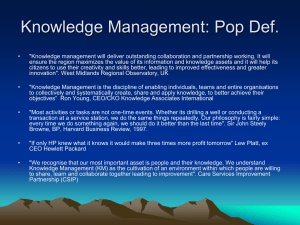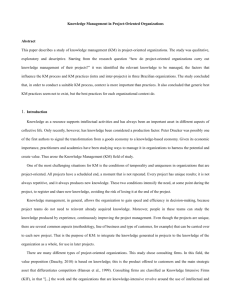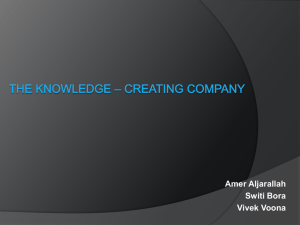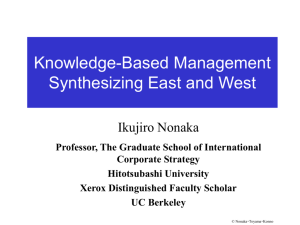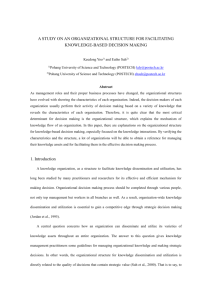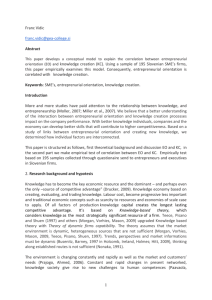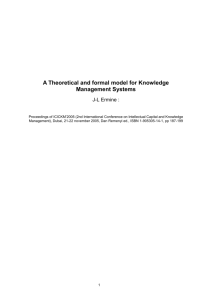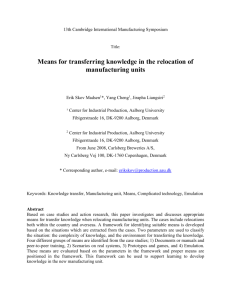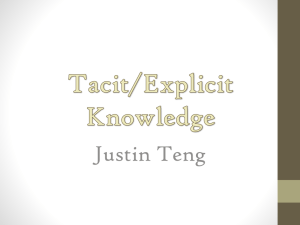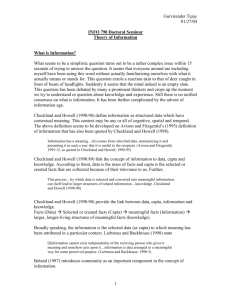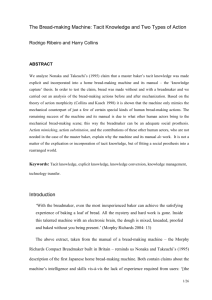Strategic knowledge Management
advertisement
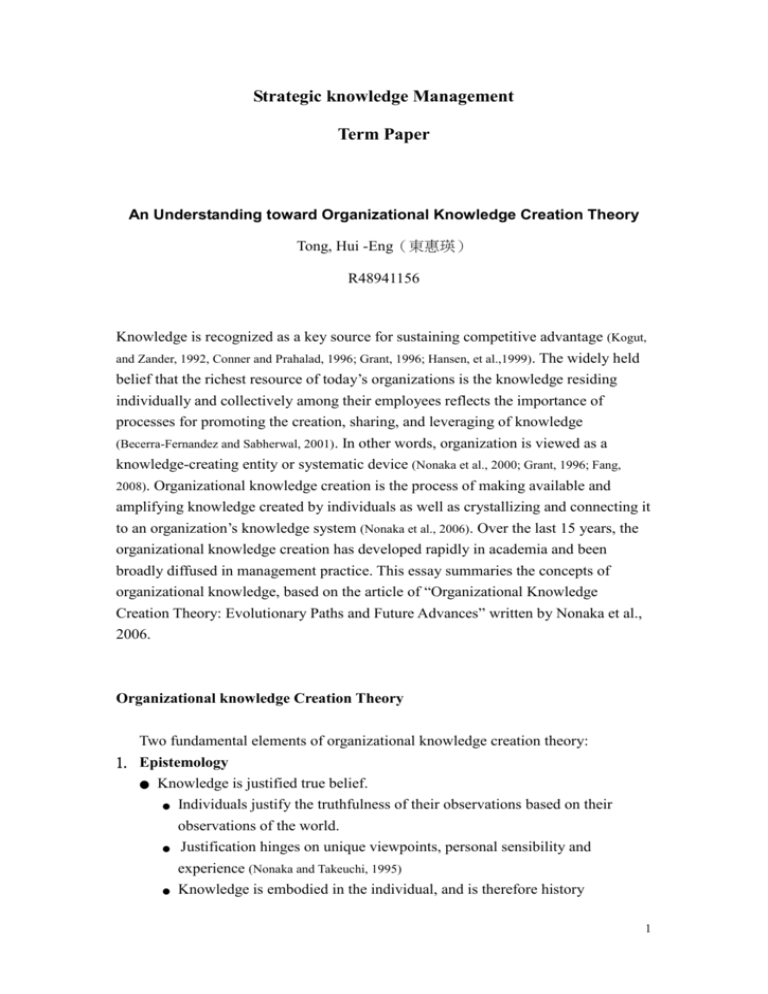
Strategic knowledge Management Term Paper An Understanding toward Organizational Knowledge Creation Theory Tong, Hui -Eng(東惠瑛) R48941156 Knowledge is recognized as a key source for sustaining competitive advantage (Kogut, and Zander, 1992, Conner and Prahalad, 1996; Grant, 1996; Hansen, et al.,1999). The widely held belief that the richest resource of today’s organizations is the knowledge residing individually and collectively among their employees reflects the importance of processes for promoting the creation, sharing, and leveraging of knowledge (Becerra-Fernandez and Sabherwal, 2001). In other words, organization is viewed as a knowledge-creating entity or systematic device (Nonaka et al., 2000; Grant, 1996; Fang, 2008). Organizational knowledge creation is the process of making available and amplifying knowledge created by individuals as well as crystallizing and connecting it to an organization’s knowledge system (Nonaka et al., 2006). Over the last 15 years, the organizational knowledge creation has developed rapidly in academia and been broadly diffused in management practice. This essay summaries the concepts of organizational knowledge, based on the article of “Organizational Knowledge Creation Theory: Evolutionary Paths and Future Advances” written by Nonaka et al., 2006. Organizational knowledge Creation Theory Two fundamental elements of organizational knowledge creation theory: 1. Epistemology ● Knowledge is justified true belief. ● Individuals justify the truthfulness of their observations based on their observations of the world. ● Justification hinges on unique viewpoints, personal sensibility and experience (Nonaka and Takeuchi, 1995) ● Knowledge is embodied in the individual, and is therefore history 1 dependent, context sensitive, specific(Varela et al, 1991). ● ● Knowledge is the capacity to define a situation and act accordingly (Stehr, 1992, 1994; von Krogh et al, 2000). Knowledge is oriented towards defining a situation or problem so as to act on it. (Varela et al, 1991; Newell and Simon 1972). Knowledge is explicit and tacit (Nonaka, 1991). Knowledge includes explicit aspects (such as language and documentation), and tacit aspects (such as experience and skills) 2. Knowledge Conversion ● Knowledge creation as a continuous process Knowledge creation is a journey from “being to becoming’ (Nonaka et al., 2006). ● Individuals enhances the capacity to define a situation or problem, and apply his or her knowledge so as to act and specifically solve the problem. In the organization, knowledge ‘become’ or ‘expands’ through a four-stage conversion process (‘SECI’). Organizational knowledge creation as a construct comprising knowledge conversion by means of externalization, internalization, socialization and combination (Nonaka et al., 1994). The concept of ‘knowledge conversion’ raises two important considerations. ● Knowledge system ● ● ● The knowledge system captures the organization’s global learning. The outcome of organization knowledge creation is re-categorized and re-contextualized this knowledge layer of the organization. The knowledge layer is embedded in the corporate vision (which outlines the fields of development for the organization) and the organizational culture (that orients individuals’ choices, mindsets, and actions. Whereas the corporate vision and the organizational culture provide the knowledge base from which to ‘tap’ tacit knowledge, technology taps the explicit knowledge in the organization (Nonaka and Takeuchi, 1995). ● ● ● The knowledge system incorporates what is termed ‘knowledge management systems’. Knowledge management systems are often equated with the information systems that assist knowledge conversion or information processes in the organization. Social justification The expansion of knowledge in the organization through conversion makes justification a social process. ● ● ● 2 ● ● Social justification should be understood as a mechanism by which the organization trades off innovation against cost containment in knowledge creation. Knowledge creation can be regarded as moving up through different organizational level, from the individual to the communities and the larger networks, and it spans sectional, departmental, divisional and organizational boundaries (Swan et al., 1999). Paths in the Evolution of Organizational Knowledge Creation Theory and Research The definition of knowledge and the concept of knowledge conversion prompted academic works on organization-enabling conditions and the context for knowledge creation. 1. Organization-Enabling Conditions and Ba ● A central purpose of organizational knowledge creation theory is to identify conditions enabling knowledge creation in order to improve innovation and learning (Nonaka, 1994; Nonaka and Takeuchi, 1995; von Krogh et al, 2000) ● Organizational knowledge creation is context dependent. ● The context for knowledge creation is ba (Nonaka and Konno, 1998). Ba is a shared space for emerging relationships. ● To participate in ba means to become engaged in knowledge creation, dialogue, adapt to and shape practices, and simultaneously transcend one’s own limited perspective or boundaries. ● Various ba characteristics are particularly suited for the conversion of knowledge (Nonaka and Konno, 1998). The awareness of a ba’s particular characteristics and their support enable successful knowledge creation (e.g. Nonaka and Konno, 1998). Organizational knowledge creation theory epitomizes a dynamic view: ● ● The organization might be a well-designed engine for information processing, but more importantly, it assiduously becomes a context in which knowledge — engine’s fuel — is created. ● Relationships among individuals in ba impact organizational knowledge’s synthesis and expansion. ● knowledge creation is more effective when relationships exhibit a high degree of care for the other (mutual trust, active empathy, access to help, leniency in judgement, and courage), particularly in the originating ba in 3 which individuals share tacit knowledge (von Krogh 1998). ● Based on the construct of care as a condition for knowledge creation, Zarraga and Bonache (2005) developed a framework that linked team atmosphere to knowledge transfer and creation. The study confirmed that high-care relationships favour both the transfer and creation of knowledge. Various types of information systems support ba and enable organizational knowledge creation (e.g. Alavi and Leidner, 2001). Chou and Wang (2003) developed and tested a model of organizational learning mechanisms and organizational information mechanisms of composite effects on organizational knowledge creation. They identified several ways in which information systems can facilitate and support ba. 2. Knowledge Vision and Activism ● The concept of ba highlighted two critical challenges for organizational knowledge creation theory. ● Whether or not the organization is successful at creating knowledge hinges on a broader set of factors than merely the knowledge outcome of team work (Zarraga & Bonache, 2005; Swan et al., 1999; Grant, 2001; Goodall & Roberts, 2003). How the organization coordinates and shares knowledge more broadly matters. Ba might have either negative (Zaleznick,1985)or positive effect on knowledge creation in groups (Nonaka et al. ,2006). Knowledge activism (von Krogh et al. 1997, 2000) ● Various forms of knowledge activism (e.g. CEO, project manager, middle-level manager) perform similar roles: they catalyse and coordinate knowledge creation and transfer, and communicate future prospects. (i) As outsiders, knowledge activists provide new input for knowledge creation. knowledge activists bring different knowledge sets, and introduced ● ● ● ‘creative abrasion’ (Leonard-Barton 1995) that leads to conflicting ideas but also new possibilities to create knowledge. (ii) Knowledge activists coordinate and transfer knowledge, by spanning the boundaries of teams and communities (e.g. Quinn et al. 1997, Wenger 2000, Newell et al. 2002). (iii)Knowledge activists communicate future prospects and so provide an overall direction for knowledge Knowledge visions 4 ● Due to the dispersed nature or organizational knowledge creation, the need for the coordination of teams and knowledge transfer, the theory of organizational knowledge creation emphasizes the development of ‘knowledge visions’ (Nonaka & Takeuchi, 1995; von Krogh et al., 2000; Nonaka et al., 2005; Giroux & Taylor, 2002). ● A knowledge vision specifies ‘potentiality for being’: the current and future organizational state, and the broad contours of knowledge that the organization should seek and create in order to move from the current to the future state (Nonaka et al. (2005). ● Knowledge vision both result from, and inspire, conversations and rhetoric throughout the organizations, and, as such, they are important resources to justify involvement in organizational knowledge creation ( see also Giroux & Taylor(2002) . 3. Organizational Forms ● Hedlund (1994) proposed that ‘heterarchy’ is superior to hierarchy as an organizational form for knowledge creation, based on the ‘Japanese vs. Western’ firm forms dichotomy (Hedlund & Nonaka, 1993; Osterloh and Frey; 2000) ● ‘Hypertext organization’ granted organizations the high capacity required to solve coordination problems inherent in knowledge creation (Nonaka ,1994; Nanaka & Takeuchi, 1995) . ● Hypertext organization is a layered structure of activities, including business system layer, and project system layer. These two layers provide distinct, purposeful bas for organizational knowledge creation and allow for both heterarchical and hierarchical coordination of these activities. The organizational form that best coordinates and enables knowledge creation is an amalgamation of three layers working in parallel: the business system, the project system and the knowledge system. Without a knowledge system, the organization would fail to share information, face rapidly increasing task complexity, develop an inability to cope with uncertainty in decision making, or repeat problem-solving errors (e.g. Lyles & Schwenk, 1992; Huber, 1991; March, 1991; Walsh & Ungson, 1991; Werr & Stjernberg, 2003). 4. Leadership ● Leadership’s primary function is to maintain efficiency in the business system layer, thus enabling knowledge creation in the project system layer, while shaping, maintaining and securing the knowledge system layer. 5 ● In keeping with the concept of the heterarchy form, leadership is distributed in ● the organization that supports the flow of knowledge from the middle to the top and down to the rest of the organization (Nonaka and Takeuchi, 1995). Middle managers promote organizational knowledge by facilitating all four modes of knowledge conversion. Leadership is about enabling knowledge creation, — not controlling and ● directing it. Top managers and middle managers are engaged in a cycle of formulating and reformulating visions that explore the ‘new territory’ envisioned by the top, while ensuring that the visions and the ‘old’ frontline realities fit. ● The organization is in a state of becoming, moving between cycles of sense-giving from the top and sense-making in the middle , to sense-giving in the middle and sense-making at the top (Gioia and Chittipeddi, 1991). 5. The Nature of the Firm and Knowledge Strategy ● The Nature of the Firm ● Firms differ because they want and strive to differ, and first and foremost, because they cannot escape the idiosyncrasy of organizational knowledge creation. Due to the intersubjective nature of knowledge, firms differ because ● organizational knowledge creation gives rise to unique organizational knowledge systems. ● Organizational knowledge creation theory proposes concepts and relationships regarding organizational enabling conditions and ba, organizational forms, as well as leadership that explain the conundrum of firm differences. Knowledge strategy ● The firm’s knowledge system layer relates to firm profit, directly (DeCarolis and Deeds 1999) or indirectly (Droge etal. 2003) , giving rise to strategic ● considerations. Knowledge assets Knowledge assets are the outcomes of knowledge creating processes through the dialogues and practices in ba, and are used to provide an analysis of knowledge system layer for strategic purposes (Nonaka et al. 2000; Nonaka and Toyama 2005). To counter the problem of ‘inertia’ or ‘core-rigidities’, firm have ‘creative routines’ to develops and accumulates knowledge assets of a ● ● 6 higher order: knowledge to create knowledge, or organizational capability to innovate and self-renew. knowledge visions, ba and the knowledge creation process that takes place in ba are part of the firm’s creative routines and it is nurtured by leadership(Nonaka & Toyama 2002, 2005; Nonaka & Reinmoeller 2002) . Knowledge assets are the focus of the firm’s strategic decision making and resource allocation aimed at aligning it with its changing environment (Nonaka et al. 2005). Managers formulate and implement knowledge strategies to build and utilize knowledge assets. The relationship between firm performance and knowledge strategy has been confirmed (Bierly & Chakrabarti, 1996; Choi & Lee ,2002). ● ● ● Knowledge strategies build distinctiveness through resource allocation. Future Advances in Organizational Knowledge Creation Theory 1. The origin of knowledge Without substantial emphasis on this topic, those analyses will be confined to knowledge-in- motion reflected in organizational becoming. 2. Ba ● ba is empirically under-explored. ● Little is known about the many factors that potentially impact the effectiveness of ba across organizations. -- to identify ways in which management can develop bas to foster knowledge processes both in teams and the organization as a whole -- to reveal the nature of interaction, relationships and learning that is bestowed on individuals as they enter, dwell in or exit ba. -- to explore ba as an aesthetic space in which groups aspire to function without compromising form and beauty. ● ● -- to explore the implications of plural epistemologies for an understanding of the nature of knowledge, its origin, and the ba. Theoretical and empirical work is needed to shed more light on the controversial issue of the possibilities of and constraints on the sharing of tacit knowledge, or the process of conversion from tacit to explicit knowledge (Gourlay 2002; Tsoukas 2003) More theoretical elaboration is needed on the interrelationships between leadership and ba in organizational knowledge creation theory. 7 -- What does leadership of, and/or in ba entail? -- What forms, shapes, energizes, positions, nurtures and transforms them? -- Is there an empirically robust and conceptually elegant theory of ‘high quality’ leadership that proposes specific and mutual interactions between leadership and ba? ● A promising line of work would be inductive theorizing in the vein of Ghoshal and Bartlett (1966), which first identified the dimensions of leadership, and thereafter the characteristics of leadership quality that created effective change in an organization. 3. The orgin of firm ● Entrepreneurship research is limited used in organizational knowledge creation theory, and particularly of the exploration of the relationship between the origin of knowledge and the origin of firms and organization -- Does the ba precede the firm, and if yes, what characterizes the ba of entrepreneurship prior to firm formation? -- What distinguishes entrepreneurial knowledge creation from knowledge creation within the boundaries of a firm? -- What spaces, discourses and stakeholders are imperative for entrepreneur’s knowledge creation (Steyaert and Katz 2004)? -- What is the relationship between entrepreneurial knowledge creation and the entrepreneur’s ability to perceive, create and profit from business opportunities? -- What is the knowledge system layer’s impact on the emerging project and business system layers in the entrepreneurial firm? -- What is the project system and business system layer’s impact on the knowledge system layer after the firm has been founded and resources acquired for business and projects? 4. The dynamics of organizational knowledge creation in organizational adaptation ● An important area for future research is not only why organizations succeed in doing all this, but also why they fail. ● Organizational failure must be studied along the temporal dimension where imbalances can emerge (Probst & Raisch 2005) (e.g. creative routines vs. easily manageable assets, applying existing knowledge assets vs. generating its capacity exploration vs. exploitation, and so on) 8 ● The organization does not build effective organizational memories and knowledge management, and the organization’s knowledge system layer falters (e.g. Argote 1999). ● The lack of knowledge vision The justification of knowledge creation hinges on the past and current utility of knowledge, driven by the immediate needs in the business system and project system layers. The firm sacrifices economy of patience for economy of speed (Nonaka and Toyama 2002): fast and effective knowledge use becomes the primary justification criterion. …. In the long run, it will fail to adapt to a changing environment, and more importantly, it loses its reason for being. ● ● ● ● ● The study of the balance in organizational knowledge creation is not only a topic for cross-sectional research (e.g. resources allocated to exploration vs. exploitation, the yearly R&D budget versus investment in operational improvement), but should also be studied as processes. Firms may create, lose and restore their balance on the temporal dimension, and it is important for future research to understand how these processes work. Comparing successful and unsuccessful organizations will lead to better predictions regarding the adaptation of organizations in the face of internal and external changes. Nonaka et al. (2006) argued that understanding relative ‘success’ requires a retrospective view of the context of entrepreneurial knowledge creation, ba and leadership, and, ultimately, the very origin of organizational knowledge. In this sense, epistemology continues to matter! Reflections Nonaka and Takeuchi (1995) proposed a rich model that conceptualized the activities of knowledge creation. However, they only presented the guidelines that can purportedly facilitate knowledge creation at a high level of generality and did not provide explicit guidance for organizational actions. In order to make the knowledge creation feasible and effective, it is important to identify the possible causality of knowledge creation. Factors that may contribute to knowledge creation and conversion need to be identified. Quantitative empirical test relating Nonaka’s knowledge creation modes to organizational performance (e.g. Lee and Choi, 2003) might verify the feasibility of the model as well. 9 Supplementary Readings 1. 方世杰、方世榮, 「知識管理—觀念架構的建立」,商管科技季刊,第一卷 第三期,頁 355-374,民國 89 年。 2. 方世杰, 「知識管理研究之本質:組織知識的統治」,民國 97 年。 3. Becerra-Fernandez, I. and Sabherwal, J. (2001), “Organizational knowledge management: A contingency perspective,” Journal of Management Information Systems, 18(1), pp.23-55. 4. Conner, K.R., and Prahalad, C.K. (1996), “A resource-based theory of the firm: knowledge versus opportunism,” Organization Science, 7( 5), pp.477-501 5. Hansen, M.; Nohria, N.; and Tierney, T. (1999), “What’s your strategy for managing knowledge?,” Harvard Business Review, 77(2), 106-119. 6. Grant, R.M. (1996), “Toward A knowledge-Based Theory of The Firm”, Strategic Management Journal, 17:109-122. 7. Kogut, B. and Zander, U. (1992), “Knowledge of the Firm, Combinative Capabilities, and the Replication of Technology”, Organization Science, 3(3):383-397. 8. Lee, H., and Choi, B. (2003), “Knowledge Management Enablers, Processes, and Organizational Performance: An Integrative View and Empirical Examination,” Journal of Management Information Systems, 20( 1), pp.179-228. 9. Nonaka, I. (1994), “ A dynamic theory of organizational knowledge creation,” 10. 11. 12. 13. Organization Science, 5( 1), pp.14-17. Nonaka, I., and Takeuchi, H. (1995), The Knowledge-creating company. New York: Oxford University Press. Nonaka, I., and Toyama, R. and Nagata, A. (2000), “A firm as a knowledge-creating entity: A new perspective on the theory of the firm,” Industrial and Corporate Change, 9(1): 1-20. Nonaka, I., and Toyama, R. (2002), “A firm as dialectical being: towards a dynamic theory of a firm,” Industrial and Corporate Change, 11(5): 995-1009. Nonaka, I., Georg von Krogh and Voelpel, S. (2006), “Organizational knowledge creation theory: Evolutionary paths and future advances,” Organization Science, 27( 8), pp.1179-1208 14. Schulze , A., and Hoegl, M. (2006), “Knowledge Creation in New Product Development Projects,” Journal of Management, 11(5): 995-1009. 10
